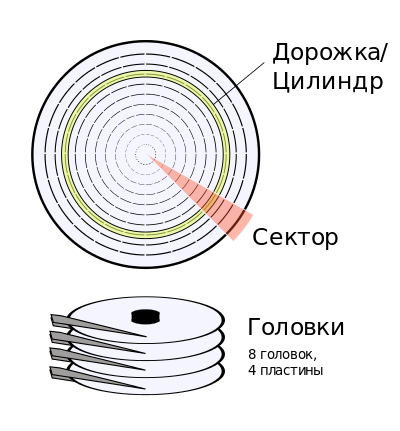
CHS (from the English Cylinder, Head, Sector - cylinder, head, sector) - a system for addressing the sector as the minimum unit of data storage in hard disk drives , floppy disk drives , etc., based on the use of physical geometry addresses drive.
In this system, a sector is addressed by a tuple of three coordinates: cylinder-head-sector (Cylinder, Head, Sector), exactly as it is physically located on the disk. In this case, the cylinder and head are counted from zero, and the sector - from one. That is, the first sector of the disk in the CHS format will have the address (0, 0, 1).
A cylinder is a set of tracks of the same radius on all magnetic surfaces of the plates of one drive [1] . The hard disk controller interprets the value into the radius by which the magnetic read head moves. Only one head reads from each magnetic surface of the magnetic disk, therefore, indicating the head, we also indicate the surface from which the information should be read. The disk sector , as is clear from the geometric definition, is interpreted as a range of degrees of rotation of the disk.
Obviously, such a scheme is not suitable for non-disk storage devices (tapes, network storages), and therefore is not used for them. The CHS circuit and its extended version of ECHS were used on early ATA drives using the ESDI interface .
In hard drives larger than 524 MB with integrated controllers, these coordinates no longer correspond to the physical position of the sector on the disk and are “logical coordinates”. So, the Large addressing mechanism reported BIOS twice as many heads and half as many cylinders. Then the controllers began reporting that there were 63 sectors {SECTOR} in the track, and 255 tracks {CYLINDER} (maximum allowable values) on the same “pancake” surface, while the number of heads was selected according to volume. It is difficult to imagine a hard drive with such characteristics - it would consist of 128 {HEAD} plates, so the controller is busy converting logical addresses to physical coordinates. The real number of sectors in a modern disk is about one hundred, and there are no more than six plates.
The logical address mechanism allows addressing more capacious disks. In addition, discs can now be divided into zones with a different number of sectors, which increases the recording density on the outer cylinders and ensures more efficient use of the plate area. This recording method is called ZBR .
Logical geometry caused problems with some versions of the BIOS and disrupted low-level utilities like Ontrack Disk Manager. This problem was solved by the LBA mechanism: now each sector received its own independent address.
Converting to LBA Addressing
- Total sectors
- : LBA block address (Logical block addressing)
- : Number of cylinders
- : Cylinder number (0 ... C-1)
- : Number of heads
- : Number of the selected head (0 ... H-1)
- : Number of sectors in one track
- : Sector number (1 ... S)
Notes
- ↑ E. Tanenbaum. Modern operating systems = Modern operating systems. - 2nd ed. - Peter , 2006 .-- 1037 p. - ISBN 0-13-031358-0 .
Literature
- Scott Muller ATA / IDE Interface: Addressing Methods for CHS and LBA // Modernization and Repair of PCs / Per. from English - 17th ed. - M .: "Williams" , 2008. - S. 606-610. - 1360 (+147 on CD) s. - ISBN 978-5-8459-1126-1 .